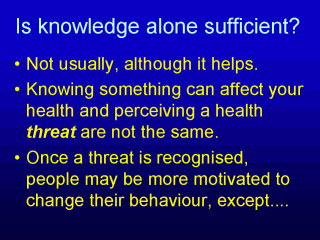 |
Knowing that something is a risk
to your health and perceiving it as a threat (the anticipation of actual or
imagined harm, which may be physical, psychological, social, financial or in any other
form) are not the same. Knowledge will not motivate consideration of behaviour change
unless it constitutes a threat to the person. Once a threat is recognized, then they may
take some action, but the action may not be what is anticipated. Threat arises when
there is the perception that some form of harm will occur. However, there is more than one
way to avoid the threat. The person can stop the behaviour associated with the threat.
This may be easy if it is not a valued or regular pattern of activity and is not
constantly cued by a range of environmental factors, such as place, people, or time
(examples of such cues are eating lunch at 1.00pm in a restaurant with your friends,
smoking a cigarette with a cup of coffee when meeting friends, and so forth). However, if
it is a regular pattern of behaviour valued by the person, there will be much less chance
of it being changed. Instead, the person can escape the threat by moving away from it
psychologically. These processes, such as cognitive dissonance and denial,
are ways that people change their thinking to avoid confronting inconsistencies between
what they do and what they believe. These processes are sometimes called psychological
defense mechanisms. |
